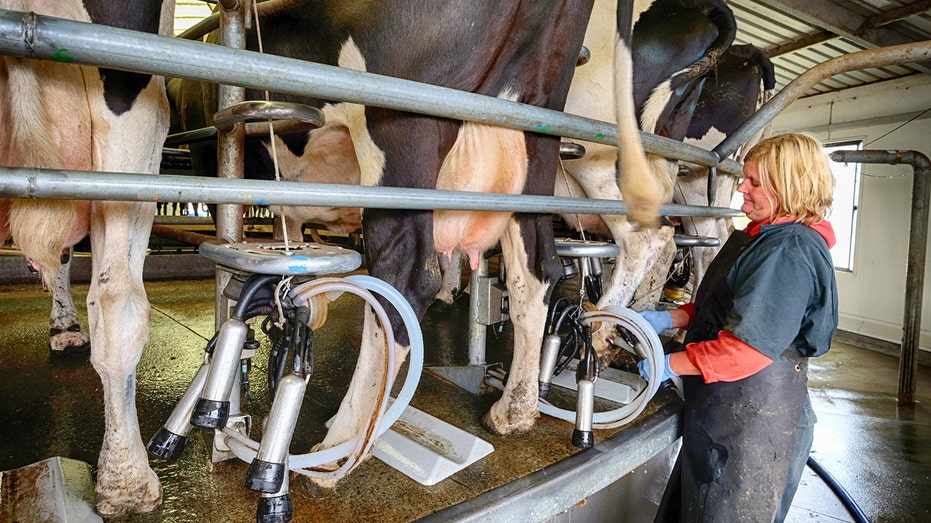China's cream cheese tea craze jacks up global milk prices
Milk prices are climbing around the globe and have reached multiyear highs, driven in part by a surprising surge in demand from China.
Growth is slowing in the world’s second-largest economy, but the country’s citizens are consuming more dairy in the form of baked goods and beverages such as tea topped with cream and cheese.
Milk products traditionally haven’t been a big part of Chinese cuisine, but people in China are drinking more milk, reaching for cream-laden desserts and incorporating cheese into everyday foods such as spring rolls and glutinous rice balls.
GOLDMAN SACHS SAYS TRUMP-CHINA TRADE WAR HAS MOVED ON TO ROUND 2
Wholesale prices of skim-milk powder, a common ingredient in commercially produced ice cream, chocolate, cakes and breads, have risen by 31%, 39% and 49% in the U.S., Europe and Oceania, respectively, in the past year. In November, the average price for the commodity across the three regions was $2,683 a metric ton, its highest average level since October 2014, according to data from the U.S. Dairy Export Council. Prices for whole-milk powder, meanwhile, are up about 14% from a year earlier.
They began climbing earlier, thanks to rising global consumption of foods that contain higher amounts of natural fat. Both types of milk powder are used in large quantities, and some food manufacturers use a combination of skim milk and edible oils to mimic the fat composition of whole milk.
The higher prices are good news for dairy farmers around the globe who have suffered through several years of low returns and milk gluts in some areas. In 2016, large quantities of excess milk were dumped in fields and other places in the U.S. following a drop in prices.
China is meeting much of its consumers’ rising demand for dairy by stepping up purchases from abroad. The country was already a big buyer of milk powder for infant formula and other foods following several scandals involving tainted domestic milk. It imported roughly a third more skim-milk powder and cream in the eight months to Aug. 31, while whole-milk powder imports rose 23%, compared with the same period a year earlier, according to Chinese customs data. Chinese production was largely stable in the first half.
Some analysts have found the jump surprising because they had earlier cautioned that U.S.-China trade tensions and a backdrop of slowing growth in the country’s economy could reduce demand for dairy.
HAVE THE CHICKEN SANDWICH WARS GONE TOO FAR?
In Beijing, at a posh dessert shop made to look like a laboratory, 31-year-old Alice Cheng sliced into a salted duck-egg yolk surrounded with thick cream. “I think it’s nice with cream,” she said.
Jason Peng, who is also 31, was in a supermarket this week buying several pouches of drinking yogurt. “I drink milk or yogurt everyday,” he said, adding that he loves dairy products. Mr. Peng said his parents encouraged his milk-drinking habit when he was a child and told him it would help him grow taller.

Morrinsville, New Zealand - April 4, 2015
The U.S. hasn’t been a significant supplier of milk powder to China. Despite that, American dairy producers are benefiting from rising demand domestically as well as in other parts of Asia and higher wholesale prices in the world’s two other major dairy-exporting regions. Dairy farms in Europe are also likely to produce less skim milk in 2020, which could create opportunities for U.S. farmers, said Alyssa Badger, director of global operations at HighGround Dairy, a Chicago-based trading and consulting firm.
Global milk production has been under some pressure this year due to dry conditions in Australia and Northern Europe. Higher feed costs have also helped damp output.
Meanwhile, a huge stockpile of skim-milk powder that the European Union started accumulating in 2015 to help farmers in the region has been sold off largely into domestic markets, China and countries in Africa and Asia, tightening global supplies.
New Zealand-based Fonterra Dairy Co-Operative Group, the world’s largest dairy exporter, has been one of the biggest beneficiaries of China’s thirst for imported milk products. The country is one of its biggest customers. The company said in late October it is selling its skim milk powder at higher prices than European and U.S. dairy companies, and expects sales of whole-milk powder to increase.
GET FOX BUSINESS ON THE GO BY CLICKING HERE
So far, China’s relatively higher rate of lactose intolerance hasn’t been a major obstacle to the country’s dairy consumption. According to the National Institutes of Health, adult lactose intolerance is most prevalent in people of East Asian descent, affecting as many as 70% to 100% of the people in some communities. That compares with a 5% rate among people of Northern European descent.
Han Xuezhen, a 26-year-old graduate student at Beijing University of Chinese Medicine, said she can’t drink milk because she is lactose intolerant. But she said she can manage a little tea-flavored ice cream and has recently developed a taste for fried rice topped with cheese.
While she generally tries to avoid eating cold foods, “a little ice cream is OK, especially when the weather warms up,” Ms. Han said.




















